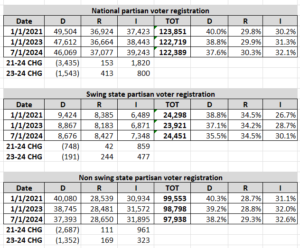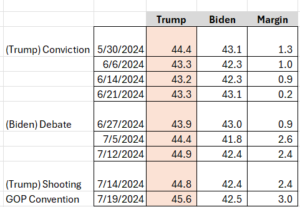We are now (from an election season perspective) in the “calm before the storm.” The Republican convention has just concluded, the opening ceremonies for the Olympics are a week from today, and then the Democratic convention convenes on August 19 in Chicago.
Primary season (for Congressional, state, legislative, and local races) is also underway across the country, with 19 states yet to hold primaries for Congressional and/or legislative races (the next scheduled primary is Arizona’s on July 30, while Louisiana’s primary coincides with the federal election day of November 5).
Today’s “Election Soundbite” will focus on just two data points: (1) partisan voter registration trends, and (2) applicable polling.
Voter registration data
In 30 states, voters register by party. Over time, party preferences of voters can change, either due to (1) changes in political attitudes a voter may have over time, or (2) newcomers’ bringing in a different set of political attitudes. To use Louisiana as an example, just 10 years ago, Democrats had a 19-point edge (47-28%, or 566K) in voter registration, while as of July 1, 2024, that Democratic plurality has noticeably narrowed over time to just a four point advantage (38-34%, or 107K).
A similar dynamic is happening at the national level, although across the country, Republicans and Independents (which JMC uses as a generic term to describe voters who are unaffiliated/registered with a third party) have alternately benefitted from the decline (in absolute numbers) in the number of registered Democrats. More specifically, in the 30 states that have party registration, Democrats went from a +10 advantage at the time President Biden was inaugurated to +9 advantage after the 2022 midterms. Since then, that advantage has narrowed somewhat more substantially to +7.
This dynamic is applicable regardless of whether we’re talking about “swing” or “non swing” states (2016/2020/2024 Presidential results are used to determine “swing states” for states having party registration): in “swing states”, Democrats went from +4 in 2021 to +3 after the midterms, and that edge is currently +1. In “non swing states”, the Democratic voter registration margin went from +12 to +10 to +9 ever since January 2021.
These voter registration trends are important, because voter registration (particularly for new registrants) is a statement of a voter’s current political leanings, and an erosion of Democratic voter registration across the country is not something national Democrats want to see, given how narrow Biden’s wins were in several states in 2020.
Polling data
When discussing polling in a Presidential contest, it’s important to understand the atmospherics that an incumbent running for re-election is facing. In President Biden’s case, his approval ratings have been “underwater” for some time (according to 538, he hasn’t had positive job approval since September 2021). Currently, his approval ratings are 42-56% approve/disapprove, according to a weighted average of the last seven days’ of polling data which JMC has compiled.
What should also concern President Biden/the Democrats is that as of this morning, former President Trump has a 3 point (46-43%) lead over Joe Biden. Two things are important to note when discussing national poll averages: (1) “big events” (Trump’s conviction, Biden’s debate performance, and the attempted assassination of Donald Trump) haven’t substantially moved the needle, which strongly suggests that the vast majority (likely in the 95-97% range) of the electorate has already decided on a Presidential candidate, but (2) even small movements nationally can and will have an outsized electoral college impact.
That last point is worth discussing further. In 2020, Joe Biden was elected President with a 4.5% popular vote margin, which translates to a 303-235 lead in the Electoral College (270 electoral votes are needed to win). If we were to assume that any shift nationally would reverberate equally across the country (while this is an imperfect assumption, the very nature of data analysis involves dealing with uncertainty and imperfection), we can see below how magnified even minute shifts in the national popular vote can have in individual states. In fact, a shift of less than a single percentage point in the national popular vote can theoretically give President Trump the 270 electoral votes he needs to win – and with his currently sitting at a 3.0% national popular vote lead, that amount of national popular vote lead theoretically puts him at 326 electoral votes:
Conclusion
President Biden (as this article is being written, the assumption is that Democrats will be unsuccessful in forcing him out of the race altogether) has his work cut out for him, and this posting was meant as a numerical illustration of the numerical challenge he faces, using voter registration and poll data as the “Exhibits A and B.”



